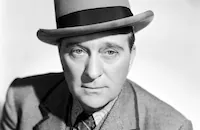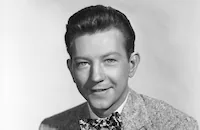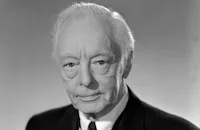Death of a Champion
Cast & Crew
Robert Florey
Lynne Overman
Virginia Dale
Joseph Allen Jr.
Donald O'connor
Susan Paley
Film Details
Technical Specs

Synopsis
At the Santa Maria Kennel Club Dog Show, elderly Guy Lanyard is accompanied by his nurse, Patsy Doyle, and his grandchildren, Gerald and Lois. Lois is engaged to Alec Temple, the secretary of the club. An exhibit at the show features Oliver Quade, the "human encyclopedia," who demonstrates his amazing photographic memory with the help of his companion, Small Fry, to promote sales of his Little Wizard encyclopedia. The police are called to the show when Lanyard's dog, Prince Laskar, is killed by a lethal injection and Albert Deacon, a judge at the show, is shot and whispers the name "Harold Blue Tooth" before dying. After police interrogate those present, Quade and Small Fry return to their room, where they are visited by Patsy, who comes to thank Quade for not reporting the syringe in her purse. While Patsy and Quade talk, Small Fry, an aspiring detective, leaves to investigate Deacon's room. When Angus McTavish, an employee recently fired by Lanyard, is found dead, Small Fry pieces the clues together and realizes that Harold Blue Tooth was a dog named for a great Danish king. When Small Fry witnesses the murder of Ma Sloane, a dog food saleswoman, he calls Quade for help, but before they can act, the two are imprisoned in a cellar by unseen hands. Breaking out using Quade's knowledge of Greek fire, the two visit the Lanyard house in hopes of exposing the killer. There, they ignite a firecracker, and the sound frightens Temple into pulling a gun, thus exposing himself as the murderer. Temple confesses that he killed to cover up the fact that he had stolen the dog that he's sold to Lanyard, and had changed his name from Harold Blue Tooth to Prince Laskar. Temple is then overpowered and brought to justice. With the crimes solved, Patsy decides to join Quade and Small Fry as they move to the domesticity of a trailer home.

Director

Robert Florey
Cast

Lynne Overman

Virginia Dale

Joseph Allen Jr.

Donald O'connor
Susan Paley

Harry Davenport

Robert Paige
May Boley
Hal Brazeale
Frank M. Thomas
David Clyde
Walter Soderling

Pierre Watkin
Bob Mckenzie
John Sheehan
Pat West
Hooper Atchley
Jack Gardner
Monte Vandergrift
Grace Hayle
Guy Usher
Alex Pollard
Wilfred Roberts
Crew
Charles Althouse
Franz Bachelin
Walter De Leon
Hans Dreier
Cortland Fitzsimmons
A. E. Freudeman
Alvin Ganzer
Louis S. Kaye
William Lebaron
Archie Marshek
Stuart Palmer
Glenn Rominger
George Templeton
Stuart Thompson
William H. Wright

Film Details
Technical Specs

Articles
Donald O'Connor, 1925-2003
Born Donald David Dixon O' Connor in Chicago on August 28, 1925, he was raised in an atmosphere of show business. His parents were circus trapeze artists and later vaudeville entertainers, and as soon as young Donald was old enough to walk, he was performing in a variety of dance and stunt routines all across the country. Discovered by a film scout at age 11, he made his film debut with two of his brothers in Melody for Two (1937), and was singled out for a contract by Paramount Pictures. He co-starred with Bing Crosby and Fred MacMurray in Sing, You Sinners (1938) and played juvenile roles in several films, including Huckleberry Finn in Tom Sawyer - Detective (1938) and the title character as a child in Beau Geste (1939).
As O'Connor grew into adolescence, he fared pretty well as a youthful hoofer, dancing up a storm in a string of low-budget, but engaging musicals for Universal Studios (often teamed with the equally vigorous Peggy Ryan) during World War II. Titles like What's Cookin', Get Hep to Love (both 1942), Chip Off the Old Block and Strictly in the Groove (both 1943) made for some fairly innocuous entertainment, but they went a long way in displaying O'Connor's athletic dancing and boyish charm. As an adult, O'Connor struck paydirt again when he starred opposite a talking mule (with a voice supplied by Chill Wills) in the enormously popular Francis (1949). The story about an Army private who discovers that only he can communicate with a talking army mule, proved to be a very profitable hit with kids, and Universal went on to star him in several sequels.
Yet if O'Connor had to stake his claim to cinematic greatness, it would unquestionably be his daringly acrobatic, brazenly funny turn as Cosmo Brown, Gene Kelly's sidekick in the brilliant Singin' in the Rain (1952). Although his self-choreographed routine of "Make "Em Laugh" (which includes a mind-bending series of backflips off the walls) is often singled out as the highlight, in truth, his whole performance is one of the highlights of the film. His deft comic delivery of one-liners, crazy facial expressions (just watch him lampoon the diction teacher in the glorious "Moses Supposes" bit) and exhilarating dance moves (the opening "Fit As a Fiddle" number with Kelly to name just one) throughout the film are just sheer film treats in any critic's book.
After the success of Singin' in the Rain, O'Connor proved that he had enough charisma to command his first starring vehicle, opposite Debbie Reynolds, in the cute musical I Love Melvin (1953). He also found good parts in Call Me Madam (1953), There's No Business Like Show Business (1954), and Anything Goes (1956). Unfortunately, his one attempt at a strong dramatic role, the lead in the weak biopic The Buster Keaton Story (1957) proved to be misstep, and he was panned by the critics.
By the '60s, the popularity of musicals had faded, and O'Connor spent the next several years supporting himself with many dinner theater and nightclub appearances; but just when it looked like we wouldn't see O'Connor's talent shine again on the small or big screen, he found himself in demand at the dawn of the '90s in a string of TV appearances: Murder She Wrote, Tales From the Crypt, Fraser, The Nanny; and movies: Robin Williams' toy-manufacturer father in Toys (1992), a fellow passenger in the Lemmon-Matthau comedy, Out to Sea (1997), that were as welcoming as they were heartening. Survivors include his wife, Gloria; four children, Alicia, Donna, Fred and Kevin; and four grandchildren.
by Michael T. Toole

Donald O'Connor, 1925-2003
Quotes
Trivia
Notes
The working title of this film was Dog Show Murder.














